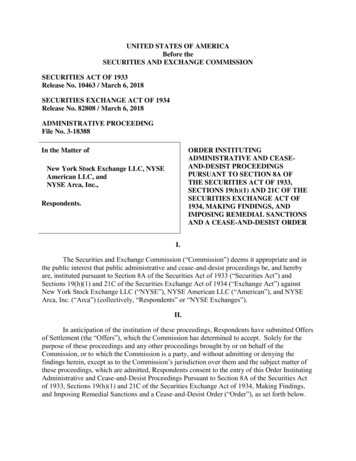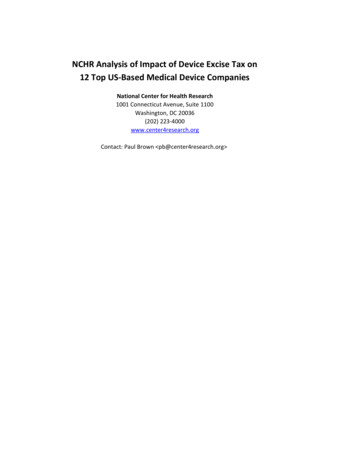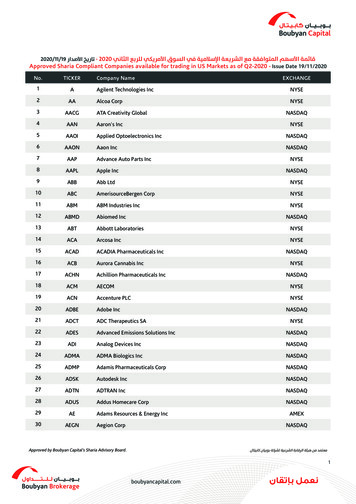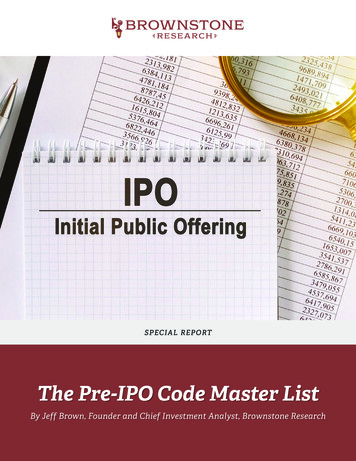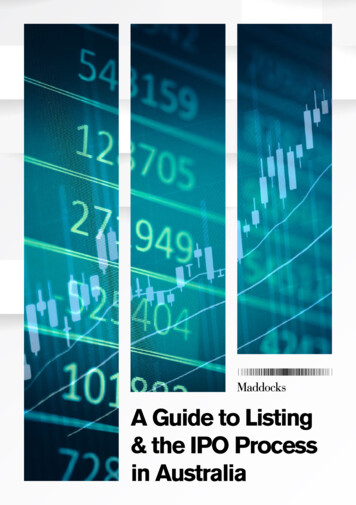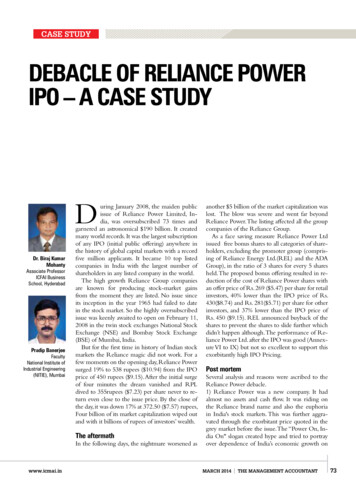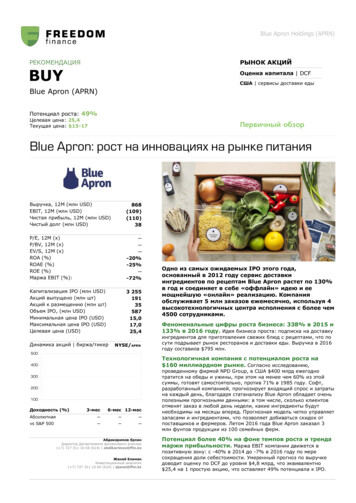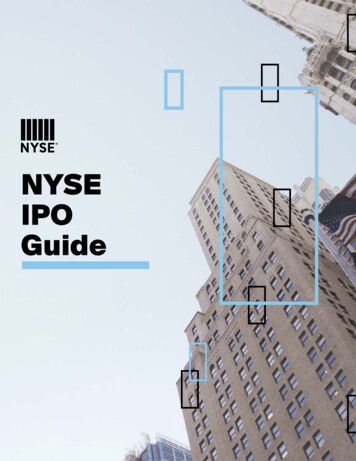
Transcription
NYSE IPOGuide
NYSE IPO GuideThird Editionwww.nyse.com/ipo
PublisherTimothy DempseyProject ManagerChloe TuckNYSE EditorialWilliam Kantrowitz and Zachary HarveyPrinting and BindingAGSNYSE IPO Guide, Third Edition,is published byCaxton Business & Legal, Inc.27 North Wacker Drive, Suite 601Chicago, IL 60606Phone: 1 312 361 0821Email: tjd@caxtoninc.comWeb: www.caxtoninc.comISBN: 978-0-9964982-5-8Copyright in individual sections rests with the copublishers. No photocopying: copyright licensesdo not apply.DISCLAIMERThe NYSE IPO Guide, Third Edition (the “Guide”),contains summary information about legal andregulatory aspects of the IPO process and iscurrent as of the date of its initial publication(April 2021). The Guide should not be relied uponas a substitute for specific legal or financialadvice from a professional. Although effortshave been made to ensure that the informationherein is correct, the Guide may contain errors oromissions, and the NYSE, the publishers, and thecontributing authors disclaim any responsibilityfor, or duty to update or correct, any such errors oromissions. The views expressed in the Guide arethose of the authors alone.Published by
NYSE IPO GuideThird Editionwww.nyse.com/ipo
Preface5Stacey CunninghamPresident, NYSE GroupIntroduction: Advantagesof listing on the NYSE7NYSE1. Why go public?1.1Advantages of conductingan IPOJ.P. Morgan (InvestmentBanking)1.2Potential issuesJ.P. Morgan (InvestmentBanking)1.3Going public withoutan offeringJ.P. Morgan (InvestmentBanking)2. Planning ahead2.1Look at your company theway investors willSimpson Thacher& Bartlett91010186.6 Market perception feedbackIHS Markit622.9 Incentive compensationarrangementsSimpson Thacher & Bartlett196.7 Investment communitydatabase and CRMIHS Markit622.10 Managing third-party riskIHS Markit226.8 ESG and the newly publiccompanyIHS Markit643. Preparing to go public3.14. The IPO process111314142.3 Revisit risk with a publiccompany mindsetSimpson Thacher & Bartlett15Choosing advisorsJ.P. Morgan (InvestmentBanking)3.2 Financial informationKPMG LLP4.12.2 Prepare to be a publiccompanySimpson Thacher& Bartlett2.4 Consider how you will getto the desired tax andorganizational structureSimpson Thacher & Bartlett2.8 Anti-takeover protectionsSimpson Thacher & BartlettProcess timelineJ.P. Morgan (InvestmentBanking)2627404.3 Underwriting, marketing,and saleJ.P. Morgan (InvestmentBanking)4347Latham & Watkins6.1Preparing an IPOcommunications strategyFTI Consulting53546.2 Communicating with themarket post-IPOFTI Consulting5658592.5 Consider the compositionof your board of directorsSimpson Thacher & Bartlett156.3 Legal framework forcommunicationsSimpson Thacher &Bartlett2.6 Review related partytransactionsSimpson Thacher & Bartlett176.4 Market intelligence andsurveillanceIHS Markit2.7176.5 Investor targeting and outreach 61IHS MarkitShareholder arrangementsSimpson Thacher & Bartlett7.1Ongoing reportingSimpson Thacher & Bartlett7.2 Listing standardsNYSE8. A public company and itsshareholders8.1415. Direct listings7. Obligations of a publiccompany676871394.2 SEC registration andprospectusSimpson Thacher & Bartlett6. IR and communications1525Proxy statement andannual meetingAST73748.2 Providing shareholderswith proxy materialAST758.3 Ownership reporting byshareholdersSimpson Thacher& Bartlett778.4 Share ownership mechanicsAST789. Managing risk9.181Liability under the federalsecurities lawsSimpson Thacher & Bartlett829.2 Class action and derivativelawsuitsMarsh839.3 IndemnificationMarsh/Simpson Thacher &Bartlett849.4 D&O liability insuranceMarsh879.5 Personal risk managementMarsh91NYSE IPO Guide3
Contents10. Foreign private issuers10.1 American depositaryreceiptsJ.P. Morgan (DepositaryReceipts Group)9410.2 The IPO process forforeign private issuersSimpson Thacher & Bartlett10.3 Financial informationKPMG LLP10.4 IR and communicationsFTI Consulting493NYSE IPO GuideAppendices103Appendix I: NYSE domesticoriginal listing standards,domestic operating companies,REITs, and funds10498Appendix lI: NYSE originallisting standards, FPIs10699Appendix III: NYSE Americanoriginal listing standards108Appendix IV: NYSE financialcontinued listing standards,US companies109100Appendix V: NYSE Americancontinued listing standardsAppendix VI: Summary offiling and other requirementsbased on issuer categoryKPMG LLPContributor profiles110111113
Prefacewww.nyse.com/ipo
PrefaceLetter from the presidentNYSE GroupCongratulations on making it to thisimportant milestone in your company’shistory. The success that has gotten youto this point comes with rewards, but thisnext step also comes with responsibilities—and we are here to help you navigate itall. As you embark on your initial publicoffering (IPO) journey, we hope you will finda valuable resource in this edition of theNYSE IPO Guide. We are grateful to all thecontributors who collaborated with us. Ourcollective goal is to help guide you throughthe process and contribute to a positive andsuccessful IPO experience.As the world’s leading exchange, theNYSE is the proud home to thousandsof successful companies of all sizes,industries and geographies. Our missionis to help companies raise money so theycan change the world. Along the way, theycreate jobs and provide opportunities forothers to invest alongside them and sharein their success. For more than 225 years,our markets, people and technology havehelped companies unlock their potential bymaintaining a commitment to transparent,orderly financial markets. The NYSE offers6NYSE IPO Guidea market model powered by the mostsophisticated trading technology in theworld and enhanced by human judgmentand accountability, resulting in access to thedeepest pools of liquidity.Listing on the NYSE or NYSE Americancarries a range of advantages, includingaccess to capital, improved branding andincreased liquidity. Importantly, it comeswith all the benefits of being a member ofthe NYSE community. Investors recognizethat if a company is NYSE listed, thecompany has met rigorous listing standards.In addition, our listed companies haveaccess to market intelligence, investoroutreach, education and advocacy. Fromlisting day and beyond, our people willhelp you connect with peers and otherbusiness leaders to gain new insights andperspectives and to help your companyshine.When companies go public—whetherthrough an IPO, a direct listing, a specialpurpose acquisition company (SPAC) orother means—the benefits extend to a broaduniverse of recipients. The companiesthemselves get access to new capital, whilethe economy benefits from those fundsbeing deployed in the form of investmentsin people, products and services. Investorsof all types, including individuals, areable to participate in the future of thesecompanies at an early stage in their lifecycles. The journey you are about to begincan create value for your organization, yourstakeholders and many others you maynever actually meet.We thank you for playing this importantrole in America’s economic prosperity.We look forward to helping you navigateyour IPO journey and reach this significantmilestone.Stacey CunninghamPresident, NYSE Group
Introduction:Advantagesof listing onthe NYSEwww.nyse.com/ipo
Introduction: Advantages of listing on the NYSEIntroductionNYSE GroupOne of the most important decisions anissuer will make during the IPO processis selecting the right exchange on whichto list the company’s securities. You arecharting your course for the future. At theNYSE, we realize how much work has goneinto building your company up to this pointand that this is the beginning of your lifeas a publicly traded company. Companieschoose to go public for a myriad ofreasons, but most notably to pursueopportunity.These opportunities vary from issuerto issuer, but the one constant is that youwant an exchange that is prepared to beby your side. The NYSE’s key differentiatorfrom other exchanges is our market model.In addition to the competitive marketmaker model used by other exchanges,the NYSE also has a Designated MarketMaker (DMM). This unique participantis required to maintain a fair and orderlymarket in the stocks it trades. Pairedwith industry-leading technology and thehuman oversight of the trading floor, stockstrade better on the NYSE.Your listing also comes with benefitsthe moment you walk through the door.Companies listing on the NYSE and NYSEAmerican join a community of iconic brandsand industry disruptors. Within this groupyou can find great customers, powerfulcollaborators, peers, mentors, acquisitionsand, potentially, your next board member.And, of course, investors.You can trust us with your future. Fromour superior trading platform to our dynamicglobal community and the lifetime ofservice and value we provide, we are here tosupport you as a public company.8NYSE IPO GuideBetter trading: The NYSE’s uniquemarket modelStocks trade better when you combineaccountability and human oversight withworld-class technology. At the center ofthis sits the DMM. DMMs are among themost sophisticated trading firms. EveryNYSE-listed company has their own DMMthat they select at the time of listing. Whilethese market makers also trade on otherexchanges, their behavior is different on theNYSE because our unique rule set includesgreater obligations for DMMs. They areresponsible for maintaining a fair and orderlymarket designed to enhance investorprotections and support issuers, especiallyduring critical times in the market—they areaccountable.In addition to the DMM, the NYSEoverlays human oversight and servicethrough our active trading floor. This meansthe NYSE is better able to manage complextransactions, navigate special situations andhelp dampen volatility.Finally, the underpinning of all this isour proprietary technology known as Pillar.This technology has resulted in significantbenefits for our issuers and their investors:more efficient processing, industry-leadingresponse times and more precise trading—abetter trading experience found only on theNYSE.Better trading matters to issuers forkey liquidity events like lock-up expirations,follow-ons and share repurchases, but italso matters to your investors. The NYSEmodel is purpose-built to give you peace ofmind when it matters most.Membership benefits: Building yourcommunity and brandBeyond trading your stock better, our jobis to help make connections, facilitateconversations and create a dynamic andengaged community. We seek to createspecific, meaningful ways for NYSE-listedcompanies to meet, share and benefit from arange of expertise and varying perspectives.That begins with advocacy and leadershipcouncils, extends to our thought leadershipand content franchise designed for yourbenefit, and continues with programmingand networking opportunities that allow youto make important connections. Our aim isto create and foster opportunities for you togrow your business and create value for yourshareholders.While the NYSE community starts withthe more than 2,000 companies listedon the NYSE, it does not end there. Ourinfluence extends to our more than 3 millionfollowers on social media, allowing you toshare your story with new audiences. Wealso have an extensive network of mediarelationships that we can leverage to giveyou the opportunity to tell your story toinvestors and stakeholders around theglobe.
1Why go public?www.nyse.com/ipo
Why go public?1.1 Advantages of conducting an IPOJ.P. Morgan (Investment Banking)When considering an IPO, a companyshould evaluate the pros and cons, aswell as the motivations for going public.This evaluation process is best conductedin conjunction with an investment bank,which can assist the company in thinkingthrough the key points. There are numerousadvantages to going public, the mostpertinent of which are detailed in thefollowing section.(a) Access to capitalGoing public affords a company accessto capital, both at the time of IPO and onan ongoing basis. An IPO can consist ofprimary and/or secondary proceeds. Acompany can raise primary capital to fundgrowth, make investments and/or repaydebt. An IPO can also provide liquidityto existing investors and give them anopportunity to sell stock.Additionally: Once the company is public, it hasaccess to an entirely new, deep andliquid source of capital forany future needs it may have. Being publicly traded adds equity tothe company’s capital-raising toolkit,enabling the company to achieve andmaintain an optimal capital structure andpotentially use stock as an acquisitioncurrency. Following the IPO, the company willbe able to tap the equity markets viafollow-on offerings of primary and/orsecondary shares, or a mix thereof.After the company has been publicfor 12 months, it will be eligible toaccess the equity capital marketsmore efficiently via a shelf registrationstatement.(b) Liquidity eventListing on the NYSE has numerous benefits,not only for the company but also for itsshareholders. As previously mentioned, theIPO can be structured such that existingowners of the company can sell down theirpositions and receive proceeds for theirshares. In addition, once the company ispublic, the existing owners can monetizetheir holdings in an efficient fashion.10NYSE IPO Guide(c) Branding event and prestigeAn IPO is a significant branding event.By listing on the NYSE, the company willreceive far-reaching media coverage,starting on the first day of trading if notbefore. Subsequent to the IPO, researchanalysts will begin to write reports on thecompany, further raising its profile. This canenhance the company’s visibility, increaseits credibility with existing and potentialcustomers and suppliersand help strengthen its competitiveposition.(d) Public currency for acquisitionsOnce the company is public, it can use itspublicly tradable common stock in wholeor in part to acquire other companies inconjunction with, or instead of, raisingadditional capital. Publicly tradable stockwith a reference price is more attractiveto target shareholders than illiquid privatecompany stock, which is more difficult tovalue.(e) Enhanced benefits for currentemployeesStock-based compensation alignsemployees’ interests with those of thecompany and its public shareholders. Byallowing employees to benefit alongsidethe company’s financial success, theseprograms increase productivity andloyalty to the company and serve as a keyselling mechanism when attracting toptalent. Furthermore, issuing equity-basedcompensation will allow the company toattract top talent without incurring additionalcash expenses. Being a public companyprovides employees with the ability tomonetize the value of their stock-basedcompensation, whether it is options orrestricted stock.1.2 Potential issuesJ.P. Morgan (Investment Banking)While there are numerous advantagesto going public, there are also severalconsiderations that the company, itsmanagement and its shareholdersshould evaluate prior to embarking on theIPO process. The most seamless IPOprocesses are for companies that fullyevaluate these considerations beforeembarking on an IPO and begin makingthe necessary preparations months, if notyears, beforehand.(a) Loss of privacy and flexibilityPrivate companies can operate withoutdisclosing proprietary information in apublic forum. However, to comply withsecurities laws, public companies mustdisclose potentially sensitive informationpublicly, which regulatory agencies, aswell as competitors, can then access. Inaddition, the focus of research analystsand investors on quarterly results andstock price performance may constrainthe operational flexibility that a privatecompany enjoys.(b) Regulatory requirements andpotential liabilityPublic companies must file various reportswith the SEC and other regulators on anongoing basis. In order to comply withdisclosure requirements, companies oftenneed to change or expand their existingpolicies and infrastructure, which can becostly and time-consuming. In addition,directors and officers are potentiallyliable for misstatements and omissionsin the registration statement and in thecompany’s ongoing reporting under theSecurities Exchange Act of 1934 (theExchange Act).(c) Sarbanes-OxleyThe Sarbanes-Oxley (SOX) Act waspassed in 2002 following a number ofmajor corporate and accounting scandals,which cost investors billions of dollars andshook public confidence in US securities’controls and disclosure. SOX set newstandards for public companies, includingrequirements relating to accounting,corporate governance, internal controlsand enhanced financial disclosure.Achieving SOX compliance can requiresignificant time, resources and capital.Although the JOBS Act relieves emerginggrowth companies (EGCs) and SEC ruleupdates in 2020 relieve smaller reportingcompanies (SRCs) of the obligation tohave their independent auditors providean attestation on internal controls underSection 404(b), they are still required toput in place internal controls sufficient formanagement to provide the certificationsrequired by Section 404(a).
Why go public?(d) Cost and distraction ofmanagement time and attentionGoing public is a relatively expensiveendeavor, with one-off and ongoing costsfor legal counsel, accounting and auditingservices, directors and officers (D&O)liability insurance, roadshow expensesand underwriting fees, as well as foradditional personnel to handle expandedreporting, compliance and investor relationsactivities. Furthermore, planning andexecuting an IPO is a time-consumingprocess that can distract managementfrom running the business day-to-day.Ongoing public company obligations shouldalso be expected to take up significantmanagement time.1.3 Going public without an offeringJ.P. Morgan (Investment Banking)Four avenues to go public in the US withouta simultaneous offering are (a) spin-offs/split-offs of existing groups or divisions ofalready public companies, (b) foreign issuerslisting American depositary receipts (ADRs)in the United States, (c) direct listings and(d) special purpose acquisition company(SPAC) mergers.(a) Spin-offs/split-offsA spin-off or split-off occurs when a publiclylisted company separates a part of itsbusiness into a different publicly listedentity. Typically, that part can function asa separate, stand-alone business, withcharacteristics distinct from those of theparent company. In a spin-off, each existinginvestor in the parent company will receiveshares in the spin-off entity pro rata toits ownership in the parent. For example,Investor A, which owns 5% of ParentCompany A, will receive 5% of the sharesoutstanding in SpinCo A. In this transaction,liquidity is generally preserved for theSpinCo, but the investor churn may beconsiderable. For example, Investor A maybe a logical shareholder of Parent CompanyA, yet dispose of the shares it receives inSpinCo A due to a variety of factors. Thesecan include differences in the businessmodel, growth profile and/or marketcapitalization, among others. To this end, itcan be difficult to control the investor basein a spin-off, whereas during an offeringprocess shares are strategically placedwith those investors known to be interestedin owning them. In a split-off, each existinginvestor in the parent company electsto own either the parent company or theseparated entity post-separation.(b) Foreign issuers listing ADRsA foreign company that is publicly tradedon an international exchange outside theUnited States can list ADRs on the NYSEwithout conducting an offering. The stockis tied to the underlying internationalsecurity and traditionally trades in tandemwith that security. While the ADR will givethe company incremental exposure toUS investors, there are often limitationson certain funds holding ADRs similar tothose limitations applying to the holdingof international investments, and typicallythe liquidity and trading of ADRs can sufferwhen compared to direct listings of theunderlying stock.Through a US listing, foreign privateissuers (FPIs) can significantly improve theiraccess to the US equity market. Demandfor foreign equities has grown considerablyamong both US institutional and individualinvestors. This demand has been driven bya need for enhanced portfolio diversification,which holdings of foreign equities canprovide, and a desire to tap into the highereconomic growth rates found in manycountries outside the United States—emerging markets, in particular.(c) Direct listingsIn a direct listing, a company’s outstandingshares are listed on a stock exchange,such as the NYSE, without an underwrittenoffering. In a direct listing, the companydoes not raise capital. Instead, the shares ofexisting stockholders, such as employeesand early-stage investors, are listed on astock exchange, enabling them to freely selltheir shares. Refer to Chapter 5 for additionalinformation on direct listings.(d) SPAC mergersA company can become publicly listed bymerging with a SPAC. A SPAC is a publiclytraded vehicle that typically has 18 to 24months from its IPO to complete an initialbusiness combination. Securities sold inSPAC IPOs are structured as units, withpublic investors receiving a common shareand a fraction of a (or full) warrant per unit.After the IPO prices, all proceeds are held intrust and accrue interest, only to be releasedupon the consummation of the acquisitionor upon liquidation of the SPAC.After an acquisition has beenannounced, public SPAC investors havetwo key decisions: (1) redeem their sharesfor a pro rata portion of the cash held intrust, or maintain their common stockownership; and (2) vote either for or againstthe acquisition. Investors benefit from bothdownside protection and warrant coverage,which provides additional upside if anacquisition closes and the stock tradesabove the 11.50 strike price. Meanwhile, theSPAC management team, or sponsor, formsthe SPAC and commits at risk capital at thetime of IPO. In return, the SPAC sponsoris entitled to entrepreneurial economics,including common stock most typicallyequating to 20% of the SPAC sharesoutstanding post-offering and sponsorwarrants.Per NYSE rules, the initial businesscombination must represent a fair marketvalue of at least 80% of the cash held intrust. The company a SPAC acquires musteffectively be public market ready, as itbecomes a publicly traded entity as soonas the initial business combination closes.Unlike an IPO where an S-1/F-1 is utilized,the S-4/proxy is the key SEC document.Among other differences, a companyincludes forward looking projections inthe merger document. The S-4/proxy istypically filed shortly after the acquisition isannounced. After a several month reviewperiod with the SEC, dates are set forthe SPAC public shareholders of record,redemption deadline and shareholdervote. The redemption deadline typicallyprecedes the shareholder meeting by twobusiness days, and results are usuallyannounced to the public at or post-closing.The proceeds (minus any redemptions),as well as any incremental capital raisedby the SPAC sponsor, can be used asprimary and/or secondary consideration tothe selling company and its shareholders.Given the proceeds from the SPAC IPO canbe redeemed in full, a SPAC sponsor mayraise committed equity in the form of eithera forward purchase agreement concurrentwith the SPAC IPO or a private investmentin public equity (PIPE) once the target hasbeen identified.NYSE IPO Guide11
2Planning aheadwww.nyse.com/ipo
Planning ahead2 Planning aheadSimpson Thacher & BartlettCompanies may take 6, 12, 18 or even 24or more months to prepare for their initialpublic offerings (IPOs) before formallyengaging underwriters and kicking offthe actual transaction. Companies in theearly planning stages of an IPO frequentlybenefit from taking steps that include thosediscussed here.2.1 Look at your company the wayinvestors willSimpson Thacher & BartlettEvery company that pursues an IPO isgoing to be compared by analysts andinvestors with other companies that arealready public. As a result, it is importantto begin to understand how your companyappears when looked at in this way and,to the maximum extent possible, use thisknowledge to take the steps necessary toensure that your company is positionedcorrectly. What different lines of business is yourcompany involved in? What publicly traded companies are inthese or similar areas? How do the research analysts and theinvestment community value thesepeers? What metrics are used to evaluate thesepeers’ performance? Are there different peer sets (withdiffering approaches to valuation andmultiples) applied to your company’sdifferent business lines?By reading the analyst reports onpotential peers while thinking about thesequestions and even taking the time to meetwith investors and analysts, you can startto understand how your company will beviewed by investors.The next step is to determine whetheryou have the ability today to capture andreport the metrics that the market is used toseeing. For example, are you able to isolateinformation about separate lines of businessthat are valued differently by the market?The answers to such questions will informwhether it makes sense to rework yourinternal and even external financial reportingso as to be able to do this. Effecting thesetypes of changes in reporting can take time.14NYSE IPO GuideHaving accessed the information thatwill allow you to view your own companylike a public market investor, what doesthis data say? For example, if you will wantyour company to be viewed as primarilybelonging with, and valued like, a particularpeer set—is that a true reflection of yourcompany’s business? Everyone involvedshould want the company to be valuedappropriately in its IPO—even without thepotential liability that could arise fromresulting shareholder lawsuits, there isperhaps nothing more painful for a companythat has recently completed an IPO thanbeing revalued downward by the marketin post-IPO trading. Consider whetherthere are acquisitions or new products (or,conversely, dispositions or discontinuances)that are on the whiteboard that may makesense to accelerate during this pretransaction phase in order to bolster theintended investment thesis. As anotherexample, evaluate how your company’sresults, whether in terms of top line growthor margins or otherwise, compare to thepeer set. Do they differ materially and, ifso, why? Are there initiatives that may bedesirable to undertake now to enhance yourcompany’s future relative performance as itwill be measured by the market?Although no one without a deepunderstanding of your business can predictwhat specific insights may be gained fromgoing through the exercise of understandinghow the market values potential peersand then viewing your own companythrough the same lens or lenses, it wouldbe quite surprising if such an exercise failsto uncover areas where an investment ofyour time and attention, and perhaps evendollars, in advance of an IPO would yieldattractive returns.2.2 Prepare to be a public companySimpson Thacher & BartlettRunning a private company with a smallnumber of shareholders or investors canbe very different than operating a publiccompany. Private companies usually lacka public company finance infrastructure,almost certainly will not have an investorrelations capability and may requireadditional resources within their legalfunction. They may also need to expandor reconfigure their management teamto ensure that they have senior officerswith the skill set to interact with a publiccompany board of directors and publiccompany investors.During the pre-transaction preparatoryphase, you should make yourself awareof the public company requirements towhich you will be subjected as part of andfollowing the IPO, and particularly thoserelated to finance and accounting (e.g.,public company accounting, internal auditand financial modeling and forecasting).The next step is to evaluate your internalcapabilities to identify deficiencies. Some ofthe key questions to ask include: Do we currently have a repeatablemonthly and quarterly close process?Do we have the ability to close our booksaccurately each quarter and to reviewand report the results to the public ona timely basis and in accordance withSecurities and Exchange Commission(SEC) guidelines? Do we have a finance departmentwith expertise in SEC accounting andreporting requirements? Many privatecompanies looking to become publiccompanies have inadequate skillsets within their finance departmentsand hire additional internal staff inconnection with going public. Do we have a finance team comfortablepreparing forecasts and projections andable to analyze current period results forreporting purposes? Are our processes and controlsadequately documented and tested?Do we have a plan to comply withSarbanes–Oxley requirements? Does our technology infrastructureadequately support our complianceefforts?Having performed this IPO readinessassessment, create—and then executeon—a realistic work plan that addressesinternal gaps and details necessaryinternal staff hires. It can take manymonths to address areas of deficiencyor weakness, and you should factorin the time and cost of evaluating andimplementing policies, building thenecessary infrastructure and makingcritical hires. Private companies oftenunderestimate the time it takes toget ready to be a public company—atransformation that needs to take placebefore, not after, the IPO.
Planning ahead2.3 Revisit risk with a public companymindsetto addressing these. Indeed, investorsare increasingly focused on how well thecompanies they invest in manage risk.Every company, whether public or private,makes risk management decisions everyday. Whether consciously, such as bydeciding to undertake an enterprise-widerisk assessment exercise, or unconsciously,such as by deciding not to hire an additionalresource in the compliance function. Oneway or the other, your company has decidedwhat balance to strike in terms of acceptingand mitigating risk.Undertaking an IPO alters a company’srisk profile. First, a com
Better trading: The NYSE's unique market model Stocks trade better when you combine accountability and human oversight with world-class technology. At the center of this sits the DMM. DMMs are among the most sophisticated trading firms. Every NYSE-listed company has their own DMM that they select at the time of listing. While
